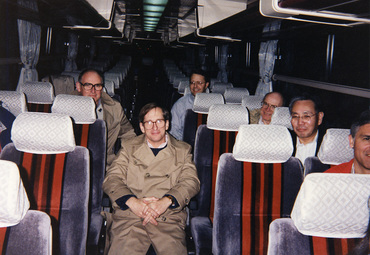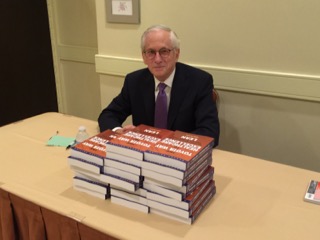 Boeing's first 1990 Japan Study Mission to Toyota.
Boeing's first 1990 Japan Study Mission to Toyota. On a visit to Japan several years ago, when I was first becoming acquainted with the concepts of Lean Manufacturing, I visited a beautiful 1,200 year old Japanese temple built of wood. It was a great reminder of the Japanese inclination to plan and act with many years of the future in mind, and it symbolized one of the most interesting paradoxes of Lean manufacturing. Lean manufacturing is a philosophy with a goal of continuous improvement over many years, yet it is based on the small acts that make up daily work. At Toyota, where the philosophy of Lean was developed, its practitioners think in terms of 100 years. They are serious when they say their goal is perfection and that after 50 years they are halfway there.
This quest for perfection is a way of life. Perfection is achieved by many small improvements made continuously. The simple but startling truth is that focusing on the long term drives us to focus on the present, rather than the past or the future. And the present is where we need to be to replace mental models about people, space, and equipment.
The organizations we work to improve today will last through our lifetime and our children’s lifetimes. Lean principles require us to embrace that long-term view and live with the consciousness that what we do today is part of a continually improving process. It is never done.
While many American consultants counsel only the big, expensive changes, the Japanese philosophy of Lean is based on small, steady, incremental changes. Instead of grandiose theories or laborious planning, the Lean outlook calls for seizing opportunities to eliminate wasted time, motion, materials, and space right now. As one of the senseis from Shingijutsu Company once said in mild exasperation, “Don’t brainstorm, trystorm! You won’t know if an idea is any good unless you’ve attempted it.”
This philosophy centers on the value of people. Part of the Lean vision is the fundamental belief in people and people-building. People must change paradigms. When changes come from the work itself, as instigated by the people who do that work, organizations change naturally. Structures change from hierarchical to flat.
When we impose cultural change by imposing great process improvements from the top, we are working counter to Lean philosophy. Recreating the foundation from the bottom, through continuous improvement, will result in an improved company that will last. But first must come a new way of looking at work—as part of a great continuum.
If thinking in terms of decades and centuries seems overwhelming, consider this: I learned from my time at Boeing that the working life of an individual employee was shorter than the products we were selling. Those who designed the 707 were no longer with us by the time I worked there. To succeed, we must remember that improvement is incremental and continuous, and so are the rewards.
This quest for perfection is a way of life. Perfection is achieved by many small improvements made continuously. The simple but startling truth is that focusing on the long term drives us to focus on the present, rather than the past or the future. And the present is where we need to be to replace mental models about people, space, and equipment.
The organizations we work to improve today will last through our lifetime and our children’s lifetimes. Lean principles require us to embrace that long-term view and live with the consciousness that what we do today is part of a continually improving process. It is never done.
While many American consultants counsel only the big, expensive changes, the Japanese philosophy of Lean is based on small, steady, incremental changes. Instead of grandiose theories or laborious planning, the Lean outlook calls for seizing opportunities to eliminate wasted time, motion, materials, and space right now. As one of the senseis from Shingijutsu Company once said in mild exasperation, “Don’t brainstorm, trystorm! You won’t know if an idea is any good unless you’ve attempted it.”
This philosophy centers on the value of people. Part of the Lean vision is the fundamental belief in people and people-building. People must change paradigms. When changes come from the work itself, as instigated by the people who do that work, organizations change naturally. Structures change from hierarchical to flat.
When we impose cultural change by imposing great process improvements from the top, we are working counter to Lean philosophy. Recreating the foundation from the bottom, through continuous improvement, will result in an improved company that will last. But first must come a new way of looking at work—as part of a great continuum.
If thinking in terms of decades and centuries seems overwhelming, consider this: I learned from my time at Boeing that the working life of an individual employee was shorter than the products we were selling. Those who designed the 707 were no longer with us by the time I worked there. To succeed, we must remember that improvement is incremental and continuous, and so are the rewards.


 RSS Feed
RSS Feed